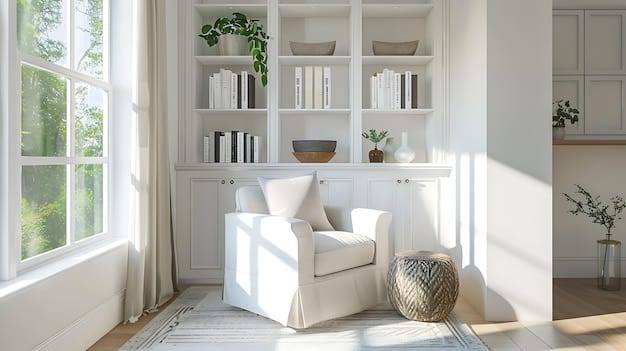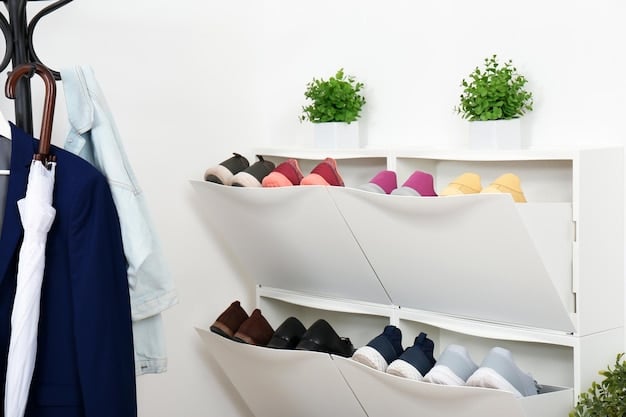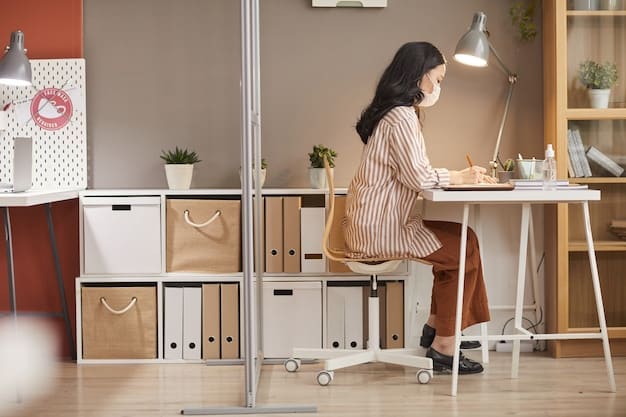Declutter Your Home in 30 Days: A 2025 Room-by-Room Guide

Anúncios
Decluttering your home in 30 days is achievable by creating a detailed, room-by-room plan focusing on donating, discarding, and organizing items to create a more peaceful and functional living space throughout 2025.
Ready to transform your living space from cluttered to serene? Want to learn how to Declutter Your Home in 30 Days: A Room-by-Room Guide for 2025?
Anúncios
Why Declutter Your Home? The Benefits Beyond Tidiness
Beyond the aesthetic appeal of a tidy home, decluttering offers a wealth of benefits for your mental and physical well-being. It’s about creating a space that supports your lifestyle and promotes a sense of calm.
Here are some key advantages of embarking on a decluttering journey:
Anúncios
Reduced Stress and Anxiety
A cluttered environment can contribute to feelings of stress and anxiety. Visual clutter overloads the senses, making it difficult to focus and relax. By removing excess items, you create a more peaceful and calming atmosphere.
Improved Focus and Productivity
A clean and organized workspace can significantly improve focus and productivity. When your surroundings are free of distractions, you’re better able to concentrate on the task at hand. This is especially important if you work from home.
- Increased Efficiency: Less time spent searching for items means more time for productive activities.
- Enhanced Creativity: A clear space can lead to a clearer mind, fostering creativity and innovation.
- Better Time Management: A decluttered home promotes better habits and routines, making it easier to manage your time effectively.
Decluttering isn’t just about getting rid of stuff; it’s about creating a better quality of life. By taking the time to streamline your belongings, you invest in your well-being and create a home that truly supports you.

Setting the Stage: Preparing for Your 30-Day Declutter
Before diving into the actual decluttering process, it’s important to prepare yourself mentally and strategically. This involves setting realistic goals, gathering necessary supplies, and creating a plan of action.
Here are some steps to take before you begin:
Define Your Goals
What do you hope to achieve through decluttering? Do you want a more minimalist lifestyle? Are you trying to create more space? Having clear goals will help you stay motivated throughout the process.
Gather Your Supplies
Make sure you have everything you need on hand before you start decluttering. This might include boxes for donations, trash bags, cleaning supplies, and organizing containers. Preparation is the key!
Create a Realistic Schedule
Attempting to declutter your entire home in one weekend is likely to lead to burnout. Instead, break the task down into smaller, manageable chunks. Allocate specific days or hours to decluttering each room.
- Start Small: Begin with a less overwhelming area, like a drawer or a shelf.
- Set Time Limits: Work in focused bursts of 30-60 minutes, then take a break.
- Reward Yourself: Celebrate your progress with small treats or activities you enjoy.
Remember, decluttering is a marathon, not a sprint. By setting realistic expectations and preparing yourself adequately, you’ll be more likely to achieve your goals and maintain a clutter-free home in the long run.
Week 1: Conquering the Living Room
The living room is often the heart of the home, where we relax, entertain, and spend time with loved ones. Unfortunately, it can also become a magnet for clutter. This week, we’ll tackle the living room and create a more inviting and functional space.
Start with these key areas:
Clear Surfaces
Start by clearing all surfaces, such as coffee tables, end tables, and shelves. Remove any items that don’t belong in the living room or that are no longer used. This can include books, magazines, electronics, and decorative items.
Organize Media and Electronics
Gather all remote controls, cables, and other electronic accessories and store them in a designated container or drawer. Donate or recycle any old or unused electronics. Sort through your media collection (DVDs, CDs, etc.) and get rid of anything you no longer watch or listen to.

Tackle Storage Spaces
Go through your shelves, cabinets, and drawers and remove anything that you no longer need or use. Donate or discard any items that are broken, damaged, or outdated. Arrange the remaining items in an organized and visually appealing manner.
By the end of week one, your living room should feel more spacious, organized, and inviting. You’ll have a clear, comfortable space to relax and enjoy your time at home.
Week 2: Taming the Kitchen
The kitchen is often the busiest room in the house, and it can quickly become overwhelmed with clutter. Food, cooking supplies, and appliances can accumulate over time, creating a chaotic and inefficient space. This week, we’ll focus on decluttering and organizing your kitchen.
Focus on these key areas:
Declutter Countertops
Clear your countertops of any appliances, utensils, or other items that you don’t use on a daily basis. Store these items in cabinets or drawers to free up valuable counter space. Keep only essential items on the countertops, such as a coffee maker or a toaster.
Organize Pantry and Cabinets
Remove everything from your pantry and cabinets and discard any expired or stale food items. Group similar items together and store them in containers or organizers to maximize space and improve visibility. Label shelves and containers to make it easier to find what you need.
Streamline Utensils and Cookware
Go through your utensils, cookware, and bakeware and get rid of anything that is broken, damaged, or no longer used. Keep only the items that you use regularly and store them in a convenient and accessible location.
At the end of week two, your kitchen should be more functional, efficient, and enjoyable to use. Clear countertops and organized storage spaces will make cooking and meal preparation a breeze.
Week 3: Organizing the Bedroom and Closets
Your bedroom should be a peaceful sanctuary where you can relax and recharge. However, clutter in the bedroom can disrupt sleep and create a sense of unease. This week, we’ll focus on decluttering and organizing your bedroom and closets.
Here are some key steps:
Declutter Surfaces
Like the living room, begin by clearing all surfaces in your bedroom, such as nightstands, dressers, and shelves. Take off everything that doesn´t belong there or that you no longer use.
Tackle Your Closet
Clear your closet and separate the clothes that you use daily, from the ones you never use. Donate the clothes that you don´t wear anymore and organize your closet.
Be mindful of what you buy
Think before you buy. Avoid impulse buys. A more consumer awareness is beneficial for your life and your wallet. Shop with intention.
- One In, One Out: Get rid of one item every time you bring a new one into your home.
- Set Limits: Have a set number of items you are willing to own for each category (clothing, books, etc.).
- Be Decisive: Avoid holding onto items “just in case.” If you haven’t used it in a year, it’s time to let it go.
By the end of week three, your bedroom should feel more calm, organized, and restful. A clutter-free bedroom will promote better sleep and overall well-being.
Week 4: Final Touches and Maintaining Your Decluttered Home
Congratulations, you’ve made it to the final week of your 30-day decluttering challenge! This week, we’ll focus on adding the finishing touches and establishing strategies for maintaining your clutter-free home in the long run.
Follow these tips:
Organize and Refresh the Bathroom
Start by decluttering the bathroom: Remove any expired or unused products from your cabinets and drawers. Wipe down surfaces and clean mirrors to create a fresh and inviting space.
Assess All Your Work
Now it´s time to see if you have passed the challange! Check all the rooms and see what you want to tweak. After this, enjoy your well-deserved clutter-free home.
Maintaining a decluttered home is an ongoing process, but it doesn’t have to be overwhelming. By incorporating these strategies into your daily routine, you can keep your home clutter-free and enjoy the benefits of a more organized and peaceful living space.
| Key Point | Brief Description |
|---|---|
| ✨ Set Clear Goals | Define objectives before you start decluttering. |
| 📅 Create a Schedule | Allocate specific days for each room to stay on track. |
| 🗑️ Donate and Discard | Get rid of anything you don’t need and donate useful items. |
| 🧹 Maintain Regularly | Keep up with regular cleaning to prevent future clutter. |
FAQ
▼
Start small with a manageable area like a drawer or shelf. This prevents overwhelm and builds momentum for bigger spaces.
▼
Ask yourself if you’ve used the item in the past year. If not, consider donating or discarding it unless it holds significant sentimental value.
▼
Yes, involve your kids! Set time limits, make it fun, and have them help decide what toys to donate. This teaches valuable organization skills.
▼
Aim for a big decluttering session every 6-12 months, with mini-sessions each season to maintain order. Regular upkeep prevents major build-up.
▼
Local charities, shelters, and thrift stores are great options. Research organizations that align with your values and needs in your community.
Conclusion
Decluttering your home in 30 days is more than just tidying up; it’s about creating a more functional and harmonious living space for 2025. By following this room-by-room guide, you’ll transform your home and achieve lasting peace of mind.





